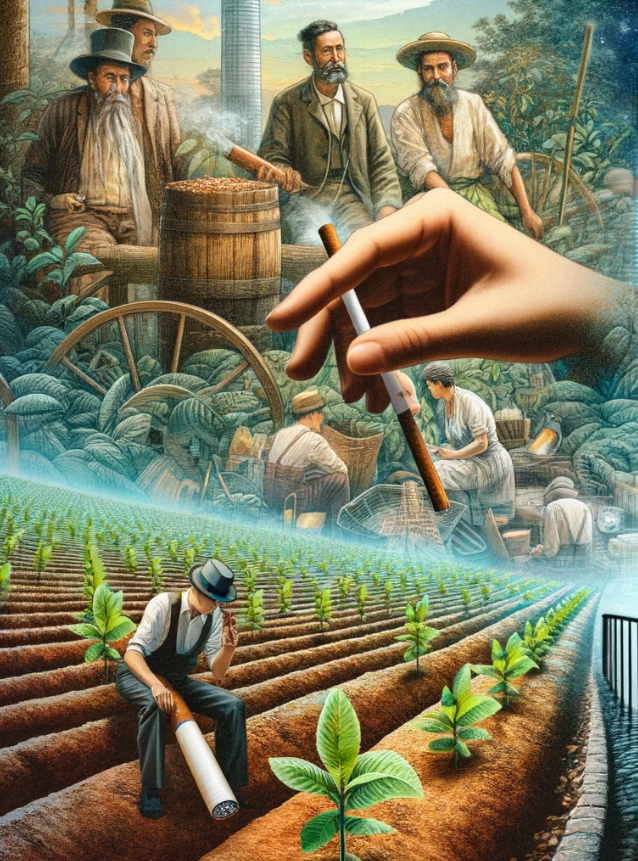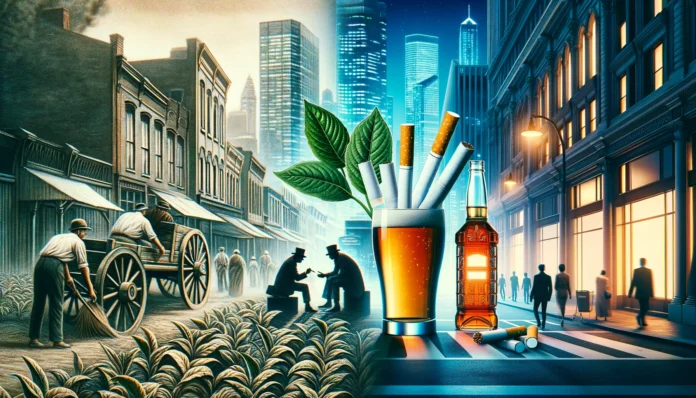Introduction
Addiction: a word that had a very positive sound with feelings of dedication during its origin gradually became considered with a negative shadow after its utilisation to describe certain habits and gestures with the potential of repetition that were and are considered unethical for the society and the individual. Addiction is now more likely defined as a condition of the human body, physiological or psychological, in which a person begins to repeat a certain act, majorly consumption of any substance that brings about a state of transient euphoria for the mind. The substances that lead to such addiction often bring about long-term physiological and/or psychological dependency for the consumer. The most common substance abused to achieve such a heightened state is tobacco, followed by alcohol and marijuana. Marijuana is still illegal in most of the countries but tobacco and alcohol are legally marketed and sold.

Addiction and Origin
Tobacco was first discovered from the plant Nicotiana tabacum and consumed in the form of smoke by Native Americans. The early colonisers realised the potential of the drug and propagated it to other colonies from where it was mass cultivated and supplied to the local population and overseas. The presence of psychostimulant Nicotine leads to heightened senses, relaxed muscle tension, and decreased reaction time which is the root cause for its abuse potential. Smoking tobacco of a particular brand was once marketed as a “healthy” habit to the extent that smoking was highly promoted at workplaces. Big-time celebrities from showbiz were hired for endorsing brands of smoked tobacco on billboards, television shows, and live performances unfazed and unaware of the hard fact of the harm that was being caused to their internal organs and life as well as to the people that were being influenced by their marketing.

Addiction and Lifestyle
As the medical knowledge and research progressed, it became evident that consumption of tobacco in any form was the leading cause of death due to pulmonary failure and cancer since it contains more than 400 types of carcinogens. Ironically, despite the establishment of the bitter fact, tobacco was still being promoted by four folds with statutory warning labels that read- CIGARETTE SMOKING IS INJURIOUS TO HEALTH and TOBACCO IS INJURIOUS TO HEALTH for chewable tobacco. By this time, alcohol had already made a place in pubs, bars and fine dine restaurants commonly being paired with cigarettes while marijuana was being experimented amongst the bohemians. With the coming of the hard rock era, a whole generation ranging from teenagers to young adults were being fed the idea of liquor, cigarettes, and marijuana along with the introduction of narcotic drugs though deemed illegal were being made available through any means possible. Many renowned celebs were even reported to have succumbed to narcotic drug overdose namely cocaine, morphine, and amphetamines but the idea of a life that had been hyped and propagated among the youth was nowhere near to be lost into oblivion.
Addiction and Progression
The years continued and by the time people realised the adverse events of their “healthy” lifestyle, it was too late. Astonishingly, there was still no fall in the consumption of illicit substances and liquor and cigarette sales skyrocketed. Governments knew that prohibiting the sale of addictive products would bring a massive setback to their respective economies since the industries associated with these products are estimated to have a global worth of 3-5 trillion US dollars. Multimillion-dollar events are sponsored by such companies to further their sales making a presence in the market horizon. Some governments even made sale of marijuana legal in certain parts of their country. Looking at the potential of the marijuana industry, governments across the world are even considering to legalise it on a regulatory basis to earn the revenue generated from its sales. Just like tobacco, marijuana will wreak havoc in the forthcoming centuries at an unimaginable scale as already witnessed in the state of Colorado, USA.
Addiction and Media
The content media often portrays the protagonist as someone who indulges in the pleasures of addiction with a label of alpha male or alpha female along with a statement that they are projecting the mirror image of the society while in reality, people are indulging in unhealthy practices of recreational drug abuse because the very media is implying to normalise these events further encouraging the youth to give it a try. Every individual is just one drag/pint/peg away to a sequelae that meets the door of suffering and life’s end.
Addiction and Stress
It has become a common ritual in the corporate houses and college/universities to go out for a cigarette smoke on an hourly basis or so to relieve stress from work. Some workplaces have separate smoking rooms/open stations for employees to burn another cigarette so that the employees don’t leave the office premises for the prized puff. Weekends are often met with bingeing on booze and getting stoned watching a web series either alone or in company of colleagues/mates. Addiction and Healthcare If we dive deeper into understanding the entire nexus, we realise that the healthcare sector holds an equal share in the dissemination of abuse potential products. The affected individuals get treated in hospitals at unaffordable prices. Rehabilitation centres serve a similar purpose at handling patients with availability of drugs inside the premises. Many drugs are sold by unfair methods that are medically prescribed with the sole idea of treatment yet there is very less evidence backed study to support the cause. The pharmaceutical industry tops it all that caters to the treatment of the patients with abuse prevention medicine. Cocaine was introduced as an alternative to suppress the cravings for morphine which only gave rise to another cobra effect. Codeine was a common constituent in cough syrups that was even administered to paediatric patients.
Addiction and Alternative
A “safer” alternative to smoking was introduced to modify the existing tobacco market in the form of e-cigarettes and vapes. After careful scrutiny it was was witnessed that one e- cigarette amounts to health deficit of 50 normal cigarettes. The best initiative to curb this potential in forthcoming generations was taken up by the government of New Zealand under the then Prime Minister Jacinda Arden who passed a law that bans the sale of cigarettes and similar tobacco products to people born after January, 2009. This single move would save future generations from the exposure and subsequent harmful effects of a perky pleasure that should be long bygone. It is the first step among many to be taken but one question still arises, will the hidden administrators of this multi trillion addiction industry ever let the people go addiction free?
Further Reading and Resources
- A policy brief that elaborates on the various economic costs associated with tobacco use, detailing both direct health care costs and indirect costs such as lost productivity due to illness and death. Learn more at Tobacconomics
- WHO provides extensive data on tobacco consumption, its health impacts, and effective measures for tobacco control. The report includes information on taxes, advertising bans, and the need for stronger regulations to curb tobacco use. Visit WHO’s official page




